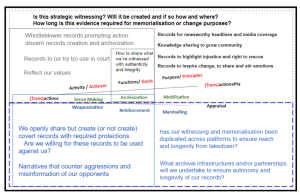10 Critical Functional Appraisal – Analysis Steps and Templates
While radical recordkeeping and appraisal is happening naturally within animal activist groups, applying Critical Functional Appraisal (CFA) to their nanosecond archiving presents a proactive model of analysis. A CFA incorporates multiple views and provenances, considers ambient functions beyond an organisational context and disrupts the mainstream narratives embedded in criminalising and governing recordkeeping practice. Radical recordkeeping infrastructure can incorporate ambient functions across multiple recordkeeping provenances, values, organisations, non-organisations and entire social movements. The complexities in risk, distributed recordkeeping, evidence over time, growing the movement (through promotion and growth), protection of whistleblowers and surveillance concerns all formulated the basis for the design of this new appraisal method. For some activists, the risk is not always something to be mitigated but sometimes embraced. Critical Functional Appraisal incorporates what the case study participants are consciously not doing or how they challenge archontic power with anarchontic power in witnessing and appraisal. The appraisal technique is transparent about political goals, supports values-based decision-making around and considers trust or distrust in the platforms used by the community. Activists appraise records at multiple points throughout the continuum and can mitigate threats of anticipatory witnessing.
Steps of a Critical Functional Analysis for Appraisal
A tool that aids appraisal by DxE needs to be as dynamic as the group itself. Rather than be created in silo, there is an opportunity for the tool to reflect the broader context and relationships across the movement and ambient societal provenance. Much of their radical appraisal already incorporates informed decision-making – by assessing risk and use of online platforms, re-editing, sharing or removing content online. Each step within the Critical Functional Analysis has a narrative quality of telling, retelling or representing DxE’s story in the broader social context. Critical Functional Analysis is providing a plan for DxE’s counternarrative. If implemented successfully, it can be the trusted narrative rather than sidelined to the institutional record. While historians have analysed and amplified unheard voices in the archive through narratives,[1] with Critical Functional Appraisal and analysis, the narrative is part of the decision-making that guides radical recordkeeping for the amplification of activist voices over time. This chapter outlines the recommended steps as a guide to performing a Critical Functional Analysis.
Risk-taking and assessment are not often discussed technologically when describing recordkeeping approaches for selecting and using activist recordkeeping platforms online. These decisions of what technologies to use in themselves is a form of appraisal. As activists have a growing understanding of overt and covert surveillance, there is increasing knowledge of risk and potential behaviour change in reaction to those risks or mitigating those risks. Risk management is needed in various examples across the recordkeeping landscape in the platforms DxE uses, as part of the risk hermeneutic described in chapter six. For example, there is risk mitigation to ensure the protection of whistleblower records over platforms over time. The decisions and appraisal approach also balance the embracing of risks as a tactic to achieve the groups’ strategic aims.
The modelling in this book provides models and techniques to address needs for activist recordkeeping longevity and curation, ones that reflect the self-empowered nature of the activist group and their potentially multiple and complex online identities over time and space.
Table 10.1 Performing Critical Functional Appraisal Using Four Steps.
Step 1 – Interviews, vignette & platform/witnessing analysis to agree on the goals, values, principles and ambient functions in the socio-political context of the group.
Taking forward existing discussions on recordkeeping autonomy and self-determination, assessing online platforms (used for community building, social change and activism) can add to the understanding of how this can be achieved in the future. In developing a Critical Functional Analysis, the importance of values to the activist community beyond the group itself and into the social movement as an incohesive whole means that ‘zooming in’ to specific strategic witnessing vignettes is a pathway to understanding the decisions and functions by group members and the associated risk assessments.
The aim of step one is not dissimilar to traditional functional analysis in its interviewing methodology – but the techniques and questions are values and action-focused rather than output focused. Questions for animal activists could include
- What key functions do we perform and what goals do we have that best reflect our principles, values and goals in our planning for change?
- What processes for evidencing and memorialising (narratives, events, achievements, relationships) are vital to achieving these goals?
- What are the ambient relationships, actions, events and traces that are shared by the broader social movement, prominent individuals and other movements and what are the interrelationships?
At this step, the broader socio-political context can become clearly linked to key ambient functions and principles that elicit deeper analysis, such the deep-dive into strategic witnessing events that identifies any sensitivities. priorities or threats. A vignette analysis across each quadrant of Figure 10.1 is an example that can be repeated until saturation.
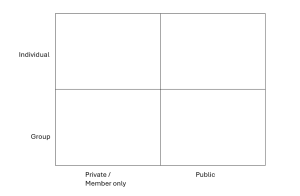
Fig. 10.1 Quadrants template.
Figure 10.1 can be downloaded for use by activist groups and is a template for the Direct Action Everywhere (DxE) analysis in chapter 7. This provides a template for analysing the spaces where records are stored and shared, linking to values, policies and procedures of the group and how these are reflected in action.
Step 2 – Analyse the decision points, key ambient functions/principles by ‘Zooming in’ on narratives, events, power, values, processes and risk in appraisal.
Mapping specific examples of functions and principles is advisable to unpack the complexity of the analysis. To ensure the Critical Functional Analysis is not just about the records artefact and to make explicit the short and long term needs of the group – the analysis of actions, events and decisions to record or not record are highlighted appraisal decision points in a flow chart. This is shown in Figure 10.2 below and illustrates the risks and issues that can be brought to light using specific examples. Each activity, event or example can be broken down step by step into the process of recordkeeping, with the key purpose/functions as the main starting point. Specific questions can be highlighted for later incorporation into the final appraisal matrix (steps 3 & 4).
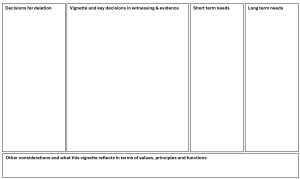
Fig. 10.2 Decision Flow Template.
In developing a method and instrument for appraisal, the importance of community values, managing risk and respecting and building archival autonomy into frameworks were critical findings of the study. In turn, structures to support radical recordkeeping should reflect the values of the activist group rather than retrofit processes into corporate recordkeeping systems and archival traditions. In doing so, shaping the infrastructures of autonomy shifts the balance of power to the activist. Below is an example vignette of DxE’s direct action against the practices of Iowa Select Farms, for which there is legal implications for the activists involved in bringing to light the hidden horror for pigs at the farm.
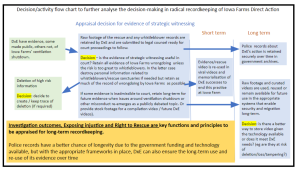
Fig. 10.3 Flowchart of Decision Points in a Case Study of DxE’s Strategic Witnessing.
Mapping and Flowcharting Decisions, Power and Values of Appraisal
While the RACM provides a theoretical framework for appraisal, there is the possibility to do microanalysis on appraisal decisions and DxE’s risk hermeneutics in action, mapping in practical terms in a vignette analysis. This analysis of decisions, risks and principles becomes part of Critical Functional Analysis. The vignette in Figure 10.3 above demonstrates direct action and strategic witnessing at Iowa Farms. This activity could be expanded from the beginning of the event, but the above is separated out to focus on the strategic witnessing in broader analysis of decisions. It reflects on the pluralisation of the undercover surveillance records to the public. The green boxes describe points of non-creation or deletion of records. The blue boxes are decisions on systems and technologies for archiving and, in the orange box is a decision to focus on archivizing and mobilising records of specific functions and principles that this vignette reflects, for example: investigation, exposé and right to rescue.
Decisions are made around the potential deletion of raw footage taken at Iowa Farms and valuing snippets of raw footage as strategic witnessing to evidence cruelty to animals and any breach of regulations. Records will be created in the preparation for readiness of being needed in court, even though some of these records will be deemed by the court as inadmissible. Decisions about the retention of this video beyond immediate use for investigation and exposé of ventilation shutdown, to provide defence in court, are represented here as short-term and long-term decisions. There is a decision about raw video footage versus curated video and pluralization of that record beyond the context of the event. Each instance could be treated differently, noting that the police-created records about DxE’s trespassing remain securely on file in a traditional archive. As evidence of strategic witnessing, these videos are key records for the broader movement and systems for long-term retention could be put in place for rescue and investigation activities by DxE more generally, not just for this one instance.
The yellow highlighted sections are appraisal opportunities or decisions – including examples of not recording animal cruelty due to whistleblower risk. This is a decision by multiple people or one person multiple times. Decision points emerge in the modelling are extracted here into a decision analysis flow chart. Rather than rely on the records of law enforcement being permanently retained by the State, the values of DxE to have their counternarrative heard is evidenced by the decision to partner with The Intercept to share the animal suffering. Investigation, exposé and rescue (and progressing the right to rescue) are all happening at once in this vignette. These together form an example of a specific event of direct-action strategic witnessing.
Step 3 – Use the Radical Appraisal Continuum Model to Map Principles and Ambient Functions to Raise Appraisal Questions.
As shown in the flowchart analysis of the Figure 10.3 visualisation of key functions and principles to saturation over multiple vignettes means repeated pertinent questions emerge over others. This leads to elevation of overarching questions and principles that guide appraisal decisions. An example of how to elevate this analysis against the (Trans)actionality axis is provided in Figure 10.4 below.
Using the understanding from previous steps, use the RACM, in particular the (Trans)actionality axis to map key questions. The RACM has an appraisal mirror axis and shadow axis that can guide decision-making for DxE’s appraisal. Viewed with the lens of highlighting power and values in each quadrant of the model, it can guide current actions and standardise future actions (though always being refined rather than static). The examples outlined in Figure 10.4 below provide an ambient view of appraisal that reveals a animal activist group’s implicit and robust recordkeeping culture within their socio-political landscape and relationships. Using the RACM as a tool gives a holistic and unbounded view of any gaps, risks or ideal narratives associated with radical recordkeeping and can guide DxE’s future decision-making.
Working top down, the black questions in bold are a starting point to help measure the value of records created and moves downward to sub-questions that reflect decisions right across the entire (Trans)actionality axis. Other questions (in grey font) are bordered by boxes that are specific to that part of the axis (e.g. authenticity and archivization are intrinsically linked). The blue text and boxes reflect the shadow axis of appraisal, with the countering of anticipatory witnessing. Assessing how to record facing these challenges is considered in the questions raised. Again, boxes are used to consider which parts of the axis are pertinent to each question (e.g. marshalling and countering this with duplication across platforms). These questions have not been solved at this time, but can be answered, reviewed and reassessed by the community (optionally in partnership with chosen experts and activist recordkeepers) and tabulated into a matrix.
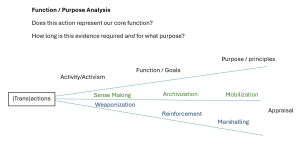
Fig. 10.5 Template: The (Trans)actions and the Mirror and Shadow Axes.
By performing analysis on the appraisal considerations above helps to consolidate questions and develop pertinent risks about longevity and systems needed to support retention of activist records. The process can be repeated for key functions to be adapted into an appraisal matrix where specific time periods to activities and values-based decisions are connected.
Step 4 – Create a repeatable matrix of risks and decisions for appraisal.
Once the analysis of functions, decisions and appraisal issues to consider has reached saturation in vignettes and data analysis, a matrix can be developed that can guide the systematic appraisal into the future. While a ‘matrix’ is proposed here (See Figure 10.6 below), there is an opportunity to move this from a tabular form to one that better represents the continuum and enables cooperative updating and evolving over time and space. Until that is developed, a shared Google Drive document would be a simple solution for a group like DxE.
We use the word matrix with extreme care because it suggests a still point in a turning world.[2]
The matrix takes into account retention decisions for the short and long term, platforms for use and assessment of new and emergent activist platforms suited to avoid anticipatory witnessing or exclusionary moderation over time. At this step, there is potential for this appraisal to be providing input into activist systems design. The values and risks of the activist group can be explored by the retention benefits to individuals, the group itself, the broader social movement, its partners and detractors. These ideas will guide systems design, creation, capture, organisation and pluralisation of activist community records. The matrix is designed to be used in practical applications of radical recordkeeping. Where there are risks that cannot be mitigated fully by the activist actions alone, the decision may be to co-design systems or security frameworks or partner with like-minded developers. Or there may be an acceptance or leaning into risk where the benefits outweigh the negatives. So rather than appraisal as a risk avoidance strategy, appraisal becomes a decision about the types of actions to take; and the types of records worth taking risks for the benefit of creating conversation for change in society. When considering its values, activists can also consider broader social movements outside their movement (like the animal liberation movement) if there is an intent for knowledge-sharing (e.g. of direct action tactics) to other communities beyond animal liberation.
Community Generated Appraisal Matrix – A Framework Analysis for Activists
The Appendix of this book provides an example matrix on an animal activist group and a draft version of their appraisal matrix that could be used for their key functions of investigations, exposé and open rescue.
Fig. 10.6 Community Collaboration on an Activism Appraisal Matrix.[3]
In the publicly shared document above (click the image to see it in a shared Google Drive and you have the option to use the ‘pop out’ ![]() icon in the top right of the preview to edit and collaborate in draw.io), there is a place to collaborate on a template for animal activism and potentially activism generally. The appraisal matrix template is designed to help activist groups systematically evaluate and manage records within their own context, focusing on several key dimensions: creation, capture, organization, pluralization, short-term needs and long-term needs. This structured approach helps activists assess and support their recordkeeping practices by addressing the risks, security and values associated with documenting and sharing their activities. Each matrix column provides a framework for making informed decisions about how to create, store and disseminate records, considering factors such as the potential for privacy breaches, the effectiveness of different platforms and the importance of maintaining accessibility over time. By applying this template, activists can develop a comprehensive strategy for managing their records, ensuring that they remain secure, accessible and aligned with their core values while adapting to evolving technological and strategic needs.
icon in the top right of the preview to edit and collaborate in draw.io), there is a place to collaborate on a template for animal activism and potentially activism generally. The appraisal matrix template is designed to help activist groups systematically evaluate and manage records within their own context, focusing on several key dimensions: creation, capture, organization, pluralization, short-term needs and long-term needs. This structured approach helps activists assess and support their recordkeeping practices by addressing the risks, security and values associated with documenting and sharing their activities. Each matrix column provides a framework for making informed decisions about how to create, store and disseminate records, considering factors such as the potential for privacy breaches, the effectiveness of different platforms and the importance of maintaining accessibility over time. By applying this template, activists can develop a comprehensive strategy for managing their records, ensuring that they remain secure, accessible and aligned with their core values while adapting to evolving technological and strategic needs.
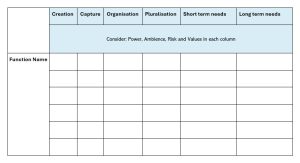
Fig. 10.7 Critical Functional Appraisal Template.
Figure 10.7 above is a blank template that can be used offline or for preparatory drafting for personal use or before contributing to the broader community board.
Movement Mobilisation into the Future using CFA
The ‘decolonizing design’ movement[4] and open software movements – shows there will be an ongoing counter culture rising up against platforms and their inbuilt biases and power – a community that can and does, use critical appraisal in systems design. Technology can mirror new forms of old power. Courtrooms for example have been deploying algorithmic decision making since the 1920s, using data for prediction of outcomes.[5] A decision tree to determine a court ruling and likelihood for criminal reoffending for example is a rudimentary tool now turned algorithm to influence courtroom decision-making.[6]
All around us, algorithms provide a kind of convenient source of authority. An easy way to delegate responsibility … [T]he algorithm is essentially the flowcharts you used at school wrapped up in a bit of mathematical manipulation.[7]
In society’s excitement to take up new technologies to make manual tasks and decision-making more straightforward, a critical assessment of these tools must be part of user appraisal before design and uptake. Diverse views on technologies can be part of the development of distributed radical recordkeeping platforms. Seeing and respecting these differences are part of establishing rights in design, contesting power dynamics that may have previously been deemed risky but necessary to take part in a social network.
Critical theory is concerned with extending a human’s consciousness of himself or herself as a social being in light of the way dominant power operates to manage knowledge.[8] A critical continuum approach allows for modelling and remodelling to refine a method to visualise and apply appraisal steps that reflects the dynamism of radical recordkeeping. The critique is embedded in the CFA approach through its community-focus and critique of traditional archiving approaches controlled by government and organisation-centric models. The CFA reflects the theoretical underpinning of activist representation in the multiverse.
Power structures are reflected in the use of our identity data “even beyond the issue of privacy and democracy”.[9] For the benefit of convenience, activists might accept this risk of data collection of linked databases trading on our identities and using them as predictions for law enforcement, such as the prediction of illegal direct action. Such examples embody “tools that crush divergence”.
Designers must discard the tools that crush divergence and nuance … New frameworks such as Socio-technical Security, and Decentralization off the shelf … [support] today’s Decolonise Design movement. Reformists must cede space for decision-making and expertise to under-represented or assailed communities.[10]
Popular platforms used for radical recordkeeping have been accused of simplistic and predatory design,[11] making the user “unthinking”[12] for what otherwise should be a complex and transparent set of privacy and security decisions. The anticipatory witnessing performed by these platforms can be disrupted by activists in their radical recordkeeping and systems design. Engaging with these risky platforms is necessary and useful in the short term, so DxE is making decisions based on assessed risk. These assessments are happening by DxE now but are not yet regarded in archival circles as appraisal decisions.
The four steps of a Critical Functional Analysis are aimed to suit radical recordkeeping, rethinking traditional appraisal practice. The Records Continuum Appraisal Model brings together philosophies, worldviews and approaches to recordkeeping and has the ability to be used as a tool to analyse complex situations in radical recordkeeping. Hence, the alignment between RACM and Critical Functional Appraisal implements a continuum view of appraisal that can be instantiated step by step. The CFA can be guided by activists themselves. Activists are already designing systems for their communities. Archivists may apply the same approach to disrupt their own practices. Systems design and use are part of the appraisal process – a concept that is articulated in International Standard ISO AS 15489[13] but there is no functional appraisal tool on how to apply this Standard in community praxis. CFA as a tool can help support these existing decisions with foresight and standardisation and make these clear or bring to light risks for new members and allied groups joining the movement.
Conclusion
- Golden, Richard M. and Natalie Zemon Davis. 1989. “Fiction in the Archives: Pardon Tales and Their Tellers in Sixteenth- Century France.” Sixteenth Century Journal 20 (1): 134. ↵
- Upward, Frank, Gillian Oliver, Barbara Reed and Joanne Evans. 2017. Recordkeeping Informatics for a Networked Age. Clayton Vic Australia: Monash University Publishing. ↵
- Jarvie-Dolinar, Katherine. 2024. Template for Community Collaboration on an Activism Appraisal Matrix, draw.io ↵
- Diehm, Cade. 2020. “This Is Fine: Optimism & Emergency in the P2P Network.” The New Design Congress, July 16. https://newdesigncongress.org/en/pub/this-is-fine. ↵
- Fry, Hannah. 2018. Hello World : Being Human in the Age of Algorithms. New York: W.W. Norton & Company, p.54. ↵
- Fry, Hannah. 2018. Hello World : Being Human in the Age of Algorithms. New York: W.W. Norton & Company, p.52. ↵
- Fry, Hannah. 2018. Hello World : Being Human in the Age of Algorithms. New York: W.W. Norton & Company, p.16 & 58-9. ↵
- Kincheloe, Joe L. 2005. Critical Constructivism Primer. Edited by Shirley R Steinberg. Peter Lang Primer. New York, Bern, Berlin, Bruxelles, Frankfurt am Main, Oxford, Wien, p.10 ↵
- Fry, Hannah. 2018. Hello World : Being Human in the Age of Algorithms. New York: W.W. Norton & Company, p.44-5. ↵
- Diehm, Cade. 2020. “This Is Fine: Optimism & Emergency in the P2P Network.” The New Design Congress, July 16, 2020. https://newdesigncongress.org/en/pub/this-is-fine. ↵
- Diehm, Cade. n.d. “On Weaponised Design.” Tactical Tech. Accessed February 4, 2022. https://ourdataourselves.tacticaltech.org/posts/30-on-weaponised-design/. ↵
- Krug, Steve. 2014. Don’t Make Me Think, Revisited : A Common Sense Approach to Web Usability. Berkeley New Riders; Berkeley, Calif.: New Riders. ↵
- Standards Australia. 2017. “AS ISO 15489.1-2002 Information and Documentation -- Records Management - Part 1: Concepts and Principles.” International Standards. ↵
Critical functional appraisal (CFA) emphasises the analysis and understanding community functions and activities that produce records. This method, with its critical focus on power dynamics, social justice, and rights in recordkeeping. The CFA considers the broader social and political context in which records are created and used. In the context of animal activist communities, critical functional appraisal can help identify and preserve records that reflect the experiences and challenges of these individuals, groups and movements, ensuring that their voices and efforts are represented and valued in the long term.
Instantaneous archiving, usually online and using technology to create, capture, organise and pluralise records (continuum-style), often concurrently. "Nanosecond archiving is a modern reality. It is not its existence that is in question in this book, only its quality."
Upward, Frank, Barbara Reed, Gillean Oliver, and Joanne Evans. 2017. “Chapter 2. A History of the Recordkeeping Single Mind, 1915–2015.” In Recordkeeping Informatics for a Networked Age. Victoria: Monash University ePress.
Jaques Derrida discusses the term "archon," which is derived from the Greek word for ruler or magistrate. The archons are the guardians of the archives, responsible for its control and authority. The archontic relates to the power and authority embedded in the act of archiving.
The anarchontic refers to the tension and conflict inherent in the process of archiving. Derrida explores the idea that the archive is not merely a passive repository of information but is subject to the dynamics of power, control, and resistance. The anarchontic actor is disruptive to structural powers of the archive, challenging the authority of the archons.
Throughout Archive Fever Jacques Derrida often references Freud's theories, linking the psychoanalytic drives with the archival process. The interplay between the archontic and anarchontic principles is central to Derrida's argument about the nature of memory, authority, and the archive.
Derrida, Jacques and Eric Prenowitz. 1996. Archive Fever: A Freudian Impression. Chicago: University of Chicago Press, 1996.
Muira McCammon describes this control as limiting what is seen and who sees it, by authorities in controlled spaces. Here the idea is expanded to a definition for distrust of surveillance online.
McCammon, Muira. “Anticipatory witnessing: military bases and the politics of pre-empting access.” Information, Communication & Society, 25, no. 7 (September 2020): 1–17.
Analysis techniques outline practical steps to Critical Functional Appraisal. Inspired by traditional functional analysis in recordkeeping, 'Critical' is added to the name to provide new ways to identify activist values and requirements for both long-term and short-term retention of records (or identifying what should not be kept at all due to risk). A Critical Functional Analysis can look forward incorporate both nanosecond archiving needs and retrospective appraisal but aims to be a practical tool applied for an activist community to own and adapt to their specific context.
"Ambience is the context of provenance ... Functions offer one possible tool for crafting ambient relationships. Ambient functions define and give meaning to agents of record-keeping within the context in which they operate."
Hurley, Chris. 1995. “Ambient Functions - Abandoned Children to Zoos.” Archivaria 40 (June): 21–39.
One example of this ambience is having a shared context of animal liberation activism. Chris Hurley’s multiple simultaneous provenances are occurring at a group level for activist group Direct Action Everywhere (DxE), but individuals and the broader movement are also co-creators and stakeholders in DxE records (at an ambient level). Hurley’s description of ambience can also be applied in the animal activism context for ambient identity and ambient purposes.
..." a framework through which we can think about the politics of media witnessing as dependent upon audience differentiation, which activists utilize as a tactical apparatus geared toward social change."
Ristovska, Sandra. 2016. “Strategic Witnessing in an Age of Video Activism.” Media, Culture and Society, 38 (7): 1034–37.
An evocative description of a scenario, situation or practice relevant to an activist group, where examples of activism are investigated for their recordkeeping requirements and analysed against the quadrants of being public, group, individual or private records and when or where these intersect and why. These can then match to group policies and values documented for the broader collective.
Where the repeated process yields enough of a pattern that new insights are no longer found.
The Trans in transactionality is bracketed here in this book to show the importance of the action, particularly for activism; and is more important than merely transactions alone (but transactions cannot be discounted, this is more like a sub-group of action).
A function is 'a set of related and ongoing activities of the business' [or community activist group]. Functions represent the major responsibilities that are managed by the organisation to fulfil its goals. Functions are high-level aggregates of the organisation's activities.
Standards Australia. 2017. “AS ISO 15489.1-2002 Information and Documentation - Records Management - Part 1: Concepts and Principles.” International Standards.

